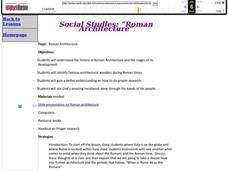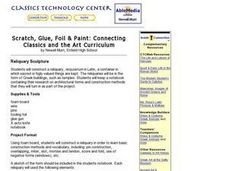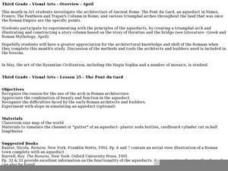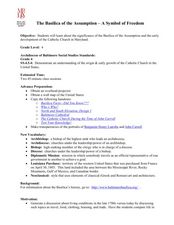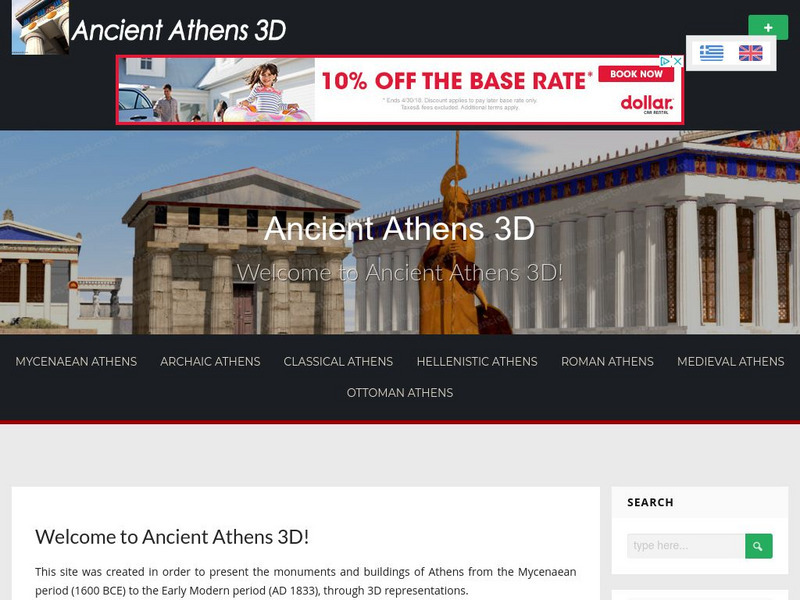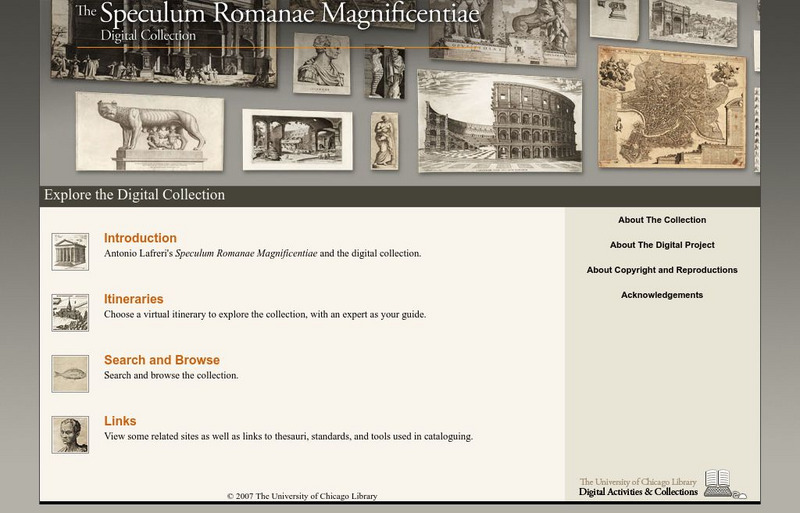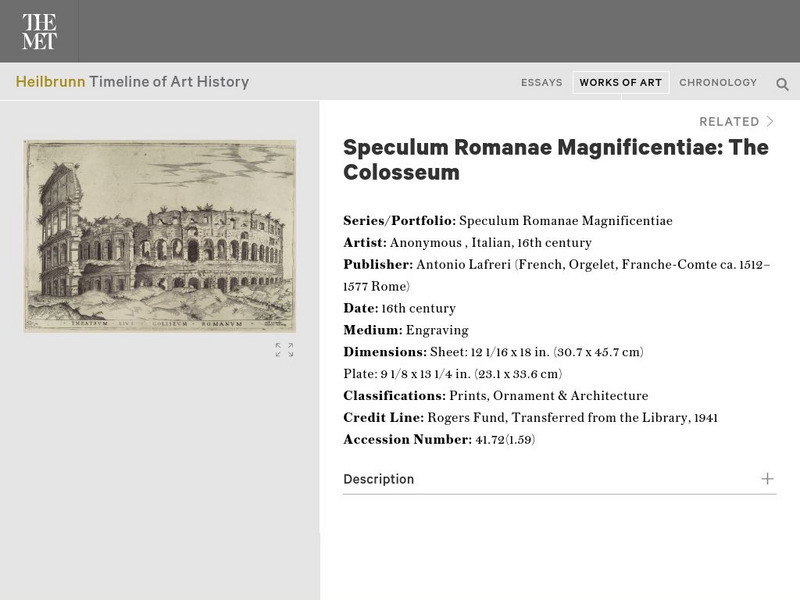Curated OER
Roman Art, Architecture, and Engineering
There is no better tool to help you explain art or architecture than an image-filled slide show. Classic Greek art, architecture, and engineering are all described with excellent visual examples and text which defines each form by its...
Curated OER
Roman Architecture
Pupils examine Roman architecture. In this ancient Rome lesson, students discuss some attributes of Roman architecture prior to conducting research on the use of classical Roman architecture in modern buildings.
Curated OER
Aqueduct Architecture: Moving Water to the Masses in Ancient Rome
Ninth graders compare ancient and modern technology in water transporting. In this lesson on the evolution of the aqueduct, 9th graders build a working aqueduct model and examine its components. They explain the importance and use of the...
Curated OER
Scratch, Glue, Foil & Paint: Connecting Classics and the Art Curriculum
Students construct a reliquary using foam board, researching basic Greek and Roman architecture and basic construction methods. They record their research and information in an architectural journal.
Curated OER
Neo-Classicism
Taking students from the origins of Neoclassical art, architecture, sculpture, painting, and decorative arts to the "sunset" of the artistic movement, this slideshow provides ample infomation and examples of the art form. The slides...
Curated OER
The Art of the Italian Renaissance
Feast your eyes on some of the most beautiful and important art of the Renaissance, including paintings, sculptures, and architecture. The slides take care to detail the characteristics of each art form, but the presentation really lends...
New Class Museum
Lesson: French Revolution and Visual Language of Power
Take a look at the French Revolution and neo-classic art, then compare it to current social issues and contemporary art. Kids analyze several pieces painted by Jacques-Louis David in regard to style and subject then compare them to...
Curated OER
Secrets of the Parthenon
Students take a closer look at the Parthenon. In this world monument lesson, students watch PBS video segments about the reconstruction of the Parthenon in Greece. Students research how the ancient Greeks built the structure and discuss...
Curated OER
Visual Arts - Overview - April
Third graders investigate the architecture of Ancient Rome, The Pont du Gard, an aqueduct in Nimes, France; The Pantheon and Trajan's Column in Rome; and various triumphal arches throughout the land that was once the Roman Empire are the...
Curated OER
Geometry of Democracy
Students explore the architecture of New England by identifying geometric shapes. In this architectural lesson, students examine photographs of classic building architecture and use a transparency to trace geometric shapes they...
Curated OER
Bestiarity and Gargoyles
Students complete an art project. In this gargoyles lesson, students learn about gargoyles and other medieval architecture features and discuss their purposes. Students create their own monsters using an etching technique. This lesson...
Curated OER
The Renaissance was a Rebirth
For this Renaissance study guide worksheet, students read a brief overview pertaining to the time period in world history and then respond to 4 reflection questions.
Curated OER
The Basilica of the Assumption-A Symbol of Freedom
Fourth graders explore the importance of the Basilica of Assumption and the development of the Catholic Church in Maryland. In this social studies instructional activity, 4th graders discuss the Basilica of the Assumption and the...
Curated OER
The Geography of Renaissance
Pupils use the internet to research the geography of the Renaissance. Using maps of Europe, they identify at least three key cities during the time period and discuss the main types of transportation. They research the various customs...
Other
Ancient Athens 3 D
This website is devoted to documenting the buildings and monuments of Athens from the Mycenaean Period to about 1800 AD. Choose an era and read about the history and structures of that time period. The last section is a complete list of...
ibiblio
Ibiblio: Learning to Read Rome's Ruins
Ibiblio offers a short account on how Renaissance scholars began to explore the ancient Roman ruins and reconstruct the Roman architectural achievements.
City University of New York
Brooklyn College: Roman Amphitheaters
A short history of the Roman amphitheater, the most famous being the Colosseum located in Rome itself. These structures were used for public games such as gladiator contests.
Curated OER
Roman Villa and Mosaics
Three pages of photos of an early Roman villa with decorative floor, wall, and bath mosaics.
ibiblio
Ibiblio: The Origins of Archaeology
An account which describes the work of Renaissance scholars to "reconstruct," ancient Rome and its architecture. A number of Renaissance manuscripts are shown. Click on "From collection to Reconstruction" (bottom of page) to go to next...
Other
Cupola Galleries: Classical Architecture Gallery
Displays photographs of famous architecture from ancient Rome. Includes shots of the Pantheon, the Colosseum, and ruins of the Roman Forum.
University of Chicago
University of Chicago: Speculum Romanae Magnificentiae
Printed images of the major architectural monuments and sculptures of ancient Rome spread knowledge of classical antiquity throughout Europe. The "Speculum Romanae Magnificentiae" (the "Mirror of Roman Magnificence") represents a...
Metropolitan Museum of Art
Metropolitan Museum of Art: Timeline of Art History: Colosseum
This resource details the neo-classical engraving of the "Colosseum" by an unkown italian artist of the 19th century, with a description and images of the engraving.
Khan Academy
Khan Academy: The Enduring Art of Marble Sculpture
In the 5th century B.C., Greek artists perfected an idealized version of the human form, representing figures with youthful, serene faces and toned bodies in elegant, balanced poses. Painters and sculptors of later centuries were greatly...
Curated OER
Unesco: Romania: Dacian Fortresses of the Orastie Mountains
Built in the 1st centuries B.C. and A.D. under Dacian rule, these fortresses show an unusual fusion of military and religious architectural techniques and concepts from the classical world and the late European Iron Age. The six...



